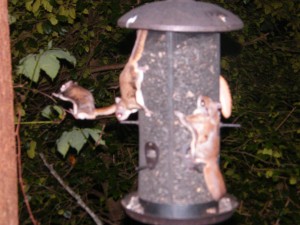I’ve written about these small nocturnal hang gliders before but I posted a pic of a group from my home, on Facebook, the other day and it produced more than 70 likes in one day (and I know it wasn’t the quality of the photo,) so I thought I would share our little adventure with you.
We went out on the deck last Friday evening to take a gander at the soon to be Super Moon. She had climbed above the mountains and was holding forth in the southeastern sky – a large, cold-white orb shimmering in the twilight. She began to take on a deeper orange glow as darkness gathered.
Denise and I were sitting and the girls were hanging out near the railing when a gray shadow cut through the dusk and thwacked against the poplar tree like a soft handclap.
“Whoa!” said Izzy, “what was that?”
“Flying squirrel,” I said as tiny toenails scraped the poplar bark and the shadow disappeared around the large tree.
Flying squirrels immediately and instinctively race around to the opposite side of whatever tree or branch they land on just in case an owl had spotted them in the air and was in hot pursuit.
Unlike its cousin, the northern flying squirrel, the southern flying squirrel, Glaucomys volans, is not endangered nor threatened. It is quite common in eastern forests from Canada to Florida.
The girls were at the corner of the deck near a large bird feeder that hangs from the poplar tree. “Just be still and quiet,” I said “and the flying squirrel will come to the feeder for a bite.”
“But there’s no food in the feeder,” Izzy said.
Wondering aloud how that could be, because I had just filled the feeder a day or two earlier, I got up, got the hook and took the feeder down and filled it. I put the feeder back up and before I got back to my chair a shadow leapt from the tree to the feeder. Momentarily, another shadow glided to the poplar, then another. It was pretty dark by then and all you could see were shadowy figures bouncing back and forth between the feeder and the tulip tree.
The girls went inside and got a flashlight. With the aid of the light we could see that the tree and feeder were alive with tiny, furry, nocturnal rodents. Southern flying squirrels range from about seven-and-a-half to 10 inches long. The soft dorsal (back) fur is gray to chestnut brown and the underside (ventral) is grayish white. There is a dark gray-black band of demarcation between the dorsal and ventral colors. The large, round black eyes are prominent. Soft loose furry membranes that extend from the fore limbs to the hind limbs unfurl like sails to catch air and let these arboreal acrobats glide. Glides of 100 to 150 feet are common and there are records of as far as 300 feet. The critters learn the art early and by eight weeks, babies are capable of 90-degree turns and loop de loops like their parents.
Like all rodents, flying squirrels have ever growing teeth. When their diet of hickory nuts, acorns, seeds, lichens, fungi and berries isn’t enough to keep those choppers sharp and fit, flying squirrels will gnaw on bones and/or antlers found in the woods as well as the bark of trees.
Southern flying squirrels can be quite vocal at times emitting a lot of high-pitched cheeps and chirps. These vocalizations help groups stay in touch with one another and serve as warnings should danger approach.
For all their high energy scurrying, bouncing and jumping, flying squirrels are actually quite approachable. I remember hand feeding flying squirrels that often made it inside our not-so-airtight shack on Horseshoe Lake when I was a kid. Izzy could gently grab the bottom of the feeder and draw it near to be nearly face to face with our furry visitors the other night.
At one time we counted eight individuals at the same time. I’m sure there were more around – no wonder the feeder was empty.

